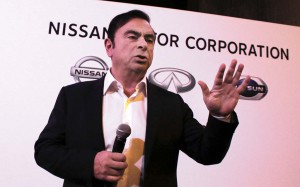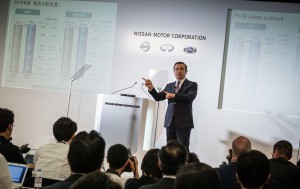
Carlos Ghosn is now the former CEO of Nissan after stepping down. He remains chairman of the automaker as well as chairman and CEO of the Alliance.
Carlos Ghosn, chairman and CEO of the Renault-Nissan Alliance, is a man of his word. In 2012, he said he planned to remain as Chairman and CEO of Nissan for five more years, and now he’s stepping down as CEO of Nissan.
Longtime Nissan executive Hiroto Saikawa, who was Nissan’s chief competitive officer until last year when he became co-CEO of Nissan and chairman of the Japanese Automobile Manufacturers Association, replaces Ghosn as Nissan CEO. Saikawa has been with Nissan since 1977.
“The change is significant. Carlos Ghosn has been an effective and strong leader for Nissan. In some ways, the degree of success future management has will reflect how successful Ghosn was in building the strongest management team,” said Stephanie Brinley, IHS Automotive senior analyst, in an email to TheDetroitBureau.
“His expertise and skill in creating working and successful alliances is critical to making the addition of Mitsubishi successful, while Nissan is strong enough for him to hand over the reins.”
(Ghosn says Nissan “will adapt” as Trump attacks rival Toyota for Mexican plants. Click Here for the story.)
Ghosn, who helped to forge the alliance between France’s Renault and Japan’s Nissan and essentially saved both automakers from ruin, will remain as chairman of Nissan and the alliance. The alliance now includes Mitsubishi after he pushed to acquire a controlling interest in the Japanese automaker in the wake of a scandal there last year.
“As Nissan’s Chairman, I will continue to supervise and guide the company, both independently and within the Renault-Nissan-Mitsubishi Alliance,” he said in a statement. Ghosn’s plans to remain as chairman of Nissan will allow him to continue to have direct input into Nissan’s growth as he looks to broaden his responsibilities.
“This planned change will also allow me to devote more time and energy to managing the strategic and operational evolution and expansion of the Alliance and ensuring that all its members benefit from the competitive advantages that its scale will deliver. I am committed to supporting the Alliance as it evolves and expands, and will continue to serve each member of the Alliance wherever and whenever necessary.”
While his duties are nebulous at this point, the Ghosn will almost certainly be looking to spend some quality time with the Alliance’s latest addition, Mitsubishi.
(Click Here for details on Nissan’s plans for an updated Leaf.)
“The change allows Ghosn to focus on the Mitsubishi integration, leaving someone in charge at Nissan that he trusts will lead well,” Brinley noted. “By appearances, Ghosn has selected a successor with strong experience and Nissan and, through serving on the Renault board, a strong foundational knowledge of Renault and how the two companies interact.
“Ghosn’s continuation as Nissan’s chairman ensures key knowledge and understanding of the company will remain accessible. However, it is also likely there will be some change in management style and direction over time.”
His ascension to the top of Renault-Nissan is automotive lore. The Brazilian-born executive came to Renault in 1996 after spending 18 years at Michelin as executive vice president of purchasing, advanced research, engineering and development, powertrain operations, and manufacturing; and he was also in charge of Renault’s South American division.
Ghosn’s restructuring of Renault’s operations turned Renault from a money loser to a money maker in less than two years. It also allowed the French automaker to assume $5.4 billion of Nissan’s debt in return for a 36.6% equity stake in the Japanese company in 1999. The “alliance” was the world’s fourth largest automaker at the time.
(Nissan looking to sell battery manufacturing operations. For more, Click Here.)
He took on the role of COO at Nissan to help turn around that company’s operations as well, and by 2001 he was CEO of Nissan. He pushed for substantial cost cuts and hastened an impressive redesign of Nissan’s product line-up to reinvigorate Nissan’s sales.

